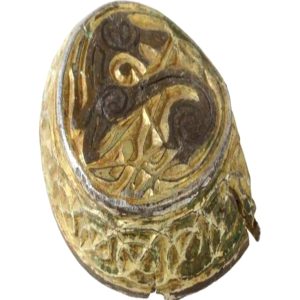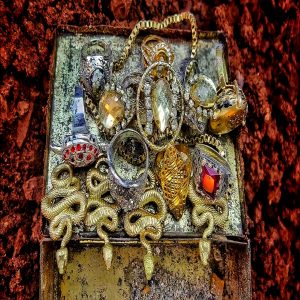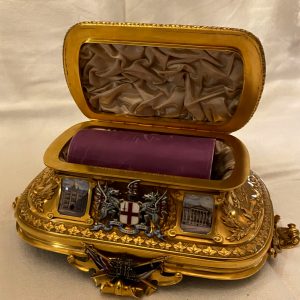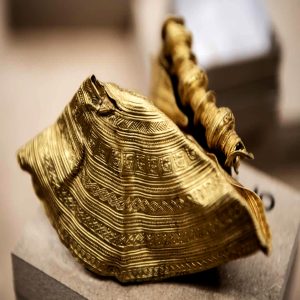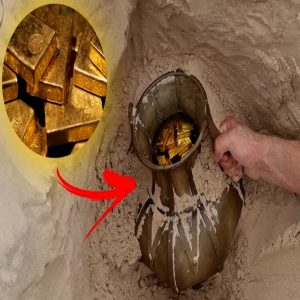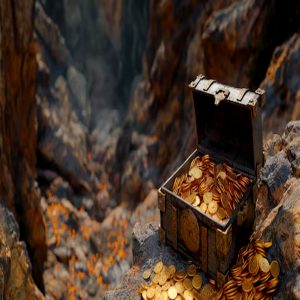Archaeologists involved in a two-year-long excavation project at the site of a planned solar energy plant near Rome unearthed something astonishing and totally unexpected.

While exploring under a section of the building site, the archaeologists discovered an ancient Roman necropolis that contained 67 elaborately dressed skeletons buried in 57 large and ornate tombs.

The Roman necropolis discovered near Rome. (Soprintendenza Archeologia Belle Arti Paesaggio Etruria Meridionale)
Insights and Opulent Secrets from the Roman Necropolis
Early testing suggests the tombs and their occupants date back to the second through fourth centuries AD. This means that the site overlaps entirely with the rule of the Roman Empire.
There is no doubt that this cemetery was reserved for rich and powerful Roman elites. The well-preserved skeletons were outfitted in golden jewelry and fancy leather footwear, and their tombs appear to have been designed to mimic the architecture of their earthly homes (as smaller versions, of course).
“We found several skeletons still wearing their expensive stockings and shoes,” lead excavation archaeologist Emanuele Giannini, who works for the private archaeological firm Eos Arc, told CNN. “All these riches, and the fact that the bones show no sign of stress or physical labor, [leads us to believe] these weren’t local farmers, but upper-crust members of Roman families coming from cities.”

Archaeologists excavating lavish graves at the elite necropolis near Rome. (Soprintendenza Archeologia Belle Arti Paesaggio Etruria Meridionale)
The elite necropolis covered a sprawling 52-acre (21-hectare) section of land on the solar plant site, which is located close to the ancient city of Tarquinia, just 50 miles (80 kilometers) northwest of Rome.
While digs associated with the solar plant project at the site have produced several other interesting finds, this discovery still surprised the archaeologists. They simply had no idea that a cemetery reserved for aristocrats would have been located where it was, given the lack of any historical reference.

The skeletal remains unearthed at the Roman necropolis were buried along with luxurious goods including gold jewelry. (Soprintendenza Archeologia Belle Arti Paesaggio Etruria Meridionale)
Building Fancy Eternal Homes for Rome’s Most Exalted
The collection of luxurious goods buried with the deceased individuals was extremely impressive. Among the highlights were silver engraved rings embedded with amber, amulets containing precious stones, many pieces of terracotta pottery, Roman coins of different values, shiny glass objects and even some still-preserved items of clothing.
This was all in addition to the golden necklaces and earrings that the deceased were found to be wearing, as it seems those responsible for organizing the burials wanted to make sure their loved ones would have all their valuables with them when they undertook their journeys to the other side.
The skeletal remains were found very close to the surface of the earth, buried at a depth of approximately 20 inches (50 cm). But fortunately for posterity, agricultural activity that might have uprooted the skeletons long ago never took place. Giannini noted that “huge limestone blocks that stick out of the ground [made] ploughing, seeding and modern farming impossible in the area. It has remained untouched for centuries.”

The Roman necropolis was found to contain many Roman artifacts. (Soprintendenza Archeologia Belle Arti Paesaggio Etruria Meridionale)
The archaeologists believe the dazzling signs of wealth on display at the ancient necropolis indicates an interest in creating final resting places that were similar or identical to the deceased individuals’ earthly residences. The interiors of the tombs were covered with cloth linings made from colorful materials in some cases, and with painted tiles or terracotta pieces in others, further enhancing an atmosphere that signaled luxury and elegance.
Family connections were important to the Romans, and this is reflected in the fact that the majority of the excavated tombs were communal (occupied by two or more individuals, who presumably were united by familial bonds). Some of the skeletons were even found buried with their arms locked together in an eternal embrace. “Building tombs for entire family nuclei is a typical ancient Roman trait,” Giannini confirmed, “but these are outstanding in their inner decor, which shows wealth and status.”
While surprised by the nature of their new discoveries, the archaeologists were hopeful of finding Roman-era artifacts when digging began. According to Emanuele Giannini, Eos Arc personnel relied on historical research, field surveys and trial trench digging to point them toward the most promising excavation sites—like the site of the newly discovered Roman necropolis, for instance, which they thought might have functioned as an ancient rest stop.
“We did have a faint idea that some treasure could lie there, as historical sources mentioned the location of a postal station for travelers near the site,” Giannini explained. “Many Romans would stop [here] for the night to eat and rest, but the magnitude of the discovery is unmatched.”
Needless to say, the unearthing of the elite Roman necropolis proved that the site had a richer history than the historical sources disclosed.

The artifacts unearthed at the Roman necropolis included valuable jewelry. (Soprintendenza Archeologia Belle Arti Paesaggio Etruria Meridionale)
Balancing the Needs of the Present with Reverence for the Past
Current plans are to remove the skeletons from the Roman necropolis sit and put them on display at a medieval fortress and tourist attraction known as Santa Severa Castle, which brings many visitors to the Italian coastal village of Santa Marinella. But researchers will spend a few months in the laboratory with the skeletons first, carrying out a series of tests that should reveal more details about who the people were, where they came from and how they lived and died.
“We are excavating a huge rural area to redevelop the land and are balancing the need to avoid ruining such unique wonders with the goal of boosting clean energy production,” Margherita Eichberg, an art heritage superintendent from Italy’s Cultural Ministry who monitors archaeological activity in the region, told CNN.
Eichberg announced that the land around the necropolis will not be leveled for construction purposes, but will instead be cordoned off and preserved for future excavations. Archaeologists are confident that more wonders will be found during their continuing excavations there and elsewhere on the larger site, which could mean even more sections of land may have to be excluded from the solar development project eventually.
“This is the fascination and beauty of Italy,” Eichberg declared in reference to the Roman necropolis. “Each time there’s a dig, incredible wonders from the past come out of the ground which need to be preserved.”
